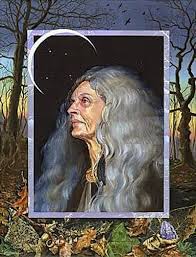The Cailleach is an ancient Celtic hag goddess who in her various guises shaped the land, controlled the forces of nature, and was responsible for the harsh nature of winter.[1] The name Cailleach has also been associated with a possible Scottish priestess cult, the Cailleach Mhor Nam Fiadh, or Cailleachan.[2]
There are many regional variants on the Cailleach in folklore, which opens up the possibility that rather than representing a single supernatural entity she actually represents a class of beings who share certain characteristics, one of which is their immense size, a common feature of Celtic divinities.[3]
Regional variations
The Cailleach’s gigantic size appears in almost all the regional accounts, as does her ability to shape the land; her great age is another shared feature.[4]
Cailleach Bheur

Wonder Tales from Scottish Myth and Legend, p. 24
The Cailleach Bheur, or Beira, of the Scottish Highlands is a blue-faced hag, the spirit of winter,[5] also known as the Gyre-Carline in Lowland Scotland. The folklorist Katharine Briggs has suggested that she may predate the Celtic entity bearing her name.[6]
According to the folklorist Donald Alexander Mackenzie, Beira was not only a goddess of winter, but also the “mother of all the gods and goddesses in Scotland” He describes her as having only one eye, a dull blue complexion, teeth as red as rust, and long white hair.[7] Beira was the daughter of Grianan, the winter sun.[a]The old Celtic calendar recognised two suns: the big sun that shone from Beltane until Halloween, and the little sun that shone from All Hallows to Beltane Eve.[6] At the beginning of spring each year the Cailleach would renew herself by drinking the waters of the Well of Youth on the mysterious Green Island of the West, where it is always summer. Revitalised, she would return to Scotland as a beautiful young woman and fall into a magical sleep. But she aged quickly, and her beauty was short-lived, so by the start of her reign over the land of Scotland from All Hallows until Beltane Eve[b]Beltane, halfway between the spring equinox and the summer solstice, usually about the first day of May, is considered to be the start of summer in the Celtic calendar. she had become once again the withered old hag described by Mackenzie.[8]
Wikimedia Commons
As well as her responsibility for the meteorology of the Scottish winter, Biera’s other task was to form the Scottish landscape, in which she was assisted by eight hags. With her magic hammer she would smash rocks and create the mountains, valleys and lochs of Highland Scotland. Perhaps the most prominent of the features she constructed was Loch Ness, named after Nessa, Biera’s maid, who as a punishment for neglecting her duties the Cailleach turned into that body of water.[9]
Biera grew older and more fierce as the winter progressed, until at last her strength was spent and she was forced to return to the Green Island once again to renew herself, thus paving the way for the arrival of Angus and Bride, the King and Queen of Summer and Plenty.[10]
Notes
| a | The old Celtic calendar recognised two suns: the big sun that shone from Beltane until Halloween, and the little sun that shone from All Hallows to Beltane Eve.[6] |
|---|---|
| b | Beltane, halfway between the spring equinox and the summer solstice, usually about the first day of May, is considered to be the start of summer in the Celtic calendar. |



